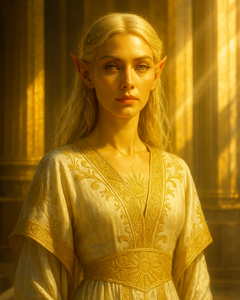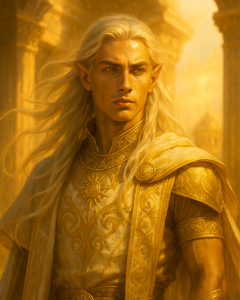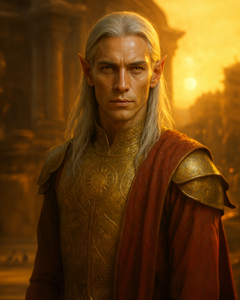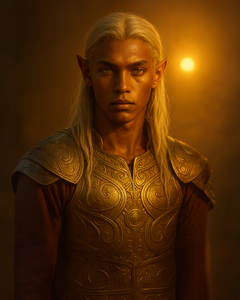Sun Elves: Difference between revisions
No edit summary |
No edit summary |
||
| Line 8: | Line 8: | ||
|major=Elf}}<blockquote><small>'''''Parent Race:''' Elf''</small></blockquote><blockquote>''<small>'''Note:''' The Sun Elves are considered a lost or extinct civilization. While their descendants, the Ash Elves, still carry fragments of their legacy, Sun Elves should not be used as a playable race by new characters.</small>''</blockquote>The '''Sun Elves''', or ''Aure’lai'', were an ancient elven race directly descended from the [[First Elves]] (''L’nai''), and were considered the pinnacle of elven civilization in the early ages. Originating from the lost continent of Aurel, they were renowned for their mastery of solar magic, monumental architecture, and military power. Their society emphasized structure, harmony, and strenght, serving as the primary shapers of ancient magical tradition. | |major=Elf}}<blockquote><small>'''''Parent Race:''' Elf''</small></blockquote><blockquote>''<small>'''Note:''' The Sun Elves are considered a lost or extinct civilization. While their descendants, the Ash Elves, still carry fragments of their legacy, Sun Elves should not be used as a playable race by new characters.</small>''</blockquote>The '''Sun Elves''', or ''Aure’lai'', were an ancient elven race directly descended from the [[First Elves]] (''L’nai''), and were considered the pinnacle of elven civilization in the early ages. Originating from the lost continent of Aurel, they were renowned for their mastery of solar magic, monumental architecture, and military power. Their society emphasized structure, harmony, and strenght, serving as the primary shapers of ancient magical tradition. | ||
Sun Elves were | Sun Elves were distinguished by their luminous features, refined mannerisms, and societal roles rooted in governance, military command, and ceremonial hierarchy. Their empire extended its influence across distant territories through conquest, diplomacy, and the institutionalization of law, education, and arcane doctrine. | ||
The fall of Aurel marked the end of the | The culture of the Aure’lai upheld rigid hierarchies and a belief in enlightened rulership, with magic acting as both a weapon and a symbol of divine order. They viewed themselves as stewards of balance and discipline—elevated not by birth alone, but by their capacity to shape reality through will and knowledge. | ||
The fall of Aurel marked the end of their supremacy. A portion of the surviving population fled eastward, eventually becoming the Ash Elves of Verokuna, adapting their arcane legacy to a new, harsher land. Though the Sun Elves are now considered extinct, their legacy endures in surviving artifacts, spellcraft traditions, and the foundational structures of elven high culture. | |||
== Etymology == | == Etymology == | ||
| Line 39: | Line 41: | ||
== Culture == | == Culture == | ||
Sun Elven society was | Sun Elven society was highly stratified, organized around arcane mastery, military discipline, and civic law. Institutions governed nearly every aspect of life, from magical education to conscription and state rites. Aurelian cities functioned as centers of bureaucracy and magical engineering, with ruling councils composed of archmages, generals, and priests. | ||
Though aloof and formal to outsiders, the Sun Elves were fiercely loyal to the ideals of order and self-mastery. They believed that through arcane structure and civic design, chaos could be subdued and the world brought into alignment with their vision of perfection. | |||
== Religion and Beliefs == | == Religion and Beliefs == | ||
Sun Elves | Sun Elves followed a system of metaphysical governance rather than conventional worship. They revered solar radiance not as a god, but as the highest manifestation of order, reason, and vitality. Religious institutions were integrated into the state, where rituals reinforced loyalty, memory, and civic duty. | ||
Key conecpts included: | |||
* '''Solar Dominion:''' The belief that the sun was a mirror of the ideal state—constant, impartial, and life-giving. | |||
* '''Arcane Mandate:''' Magic was considered a civil responsibility and divine right, entrusted to the disciplined few. | |||
* '''Cycle of Order''': A calendar of military, seasonal, and magical alignments used to guide all aspects of society. | |||
Temples were often built on sun-aligned axes, using refracted light in ritual and recordkeeping, and fire was used ceremonially. | |||
== Legacy == | == Legacy == | ||
Although the civilization of Aurel has vanished, the legacy of the Sun Elves continues through their | Although the civilization of Aurel has vanished, the legacy of the Sun Elves continues through their descendants. The Ash Elves of Verokuna carry fragments of their rites and architectural models, while the High Elves (Vel’nai) replicated their centralized governance and hierarchical traditions. | ||
In many traditions, the return | In many traditions, the return of Aurel is seen as a mythic prophecy for al elven races. | ||
Revision as of 04:58, 16 July 2025
| Sun Elf | |
|---|---|
| Major race | |
 Example appearance | |
| Attributes | |
| Average lifespan (max) | 1200 years (1600) |
| Age of maturity | 300 years |
| Height range | 1.75 - 2.20 m (5′9′′ - 7′30′′) |
Parent Race: Elf
Note: The Sun Elves are considered a lost or extinct civilization. While their descendants, the Ash Elves, still carry fragments of their legacy, Sun Elves should not be used as a playable race by new characters.
The Sun Elves, or Aure’lai, were an ancient elven race directly descended from the First Elves (L’nai), and were considered the pinnacle of elven civilization in the early ages. Originating from the lost continent of Aurel, they were renowned for their mastery of solar magic, monumental architecture, and military power. Their society emphasized structure, harmony, and strenght, serving as the primary shapers of ancient magical tradition.
Sun Elves were distinguished by their luminous features, refined mannerisms, and societal roles rooted in governance, military command, and ceremonial hierarchy. Their empire extended its influence across distant territories through conquest, diplomacy, and the institutionalization of law, education, and arcane doctrine.
The culture of the Aure’lai upheld rigid hierarchies and a belief in enlightened rulership, with magic acting as both a weapon and a symbol of divine order. They viewed themselves as stewards of balance and discipline—elevated not by birth alone, but by their capacity to shape reality through will and knowledge.
The fall of Aurel marked the end of their supremacy. A portion of the surviving population fled eastward, eventually becoming the Ash Elves of Verokuna, adapting their arcane legacy to a new, harsher land. Though the Sun Elves are now considered extinct, their legacy endures in surviving artifacts, spellcraft traditions, and the foundational structures of elven high culture.
Etymology
- Sun Elves: A term used by historians to distinguish this lineage from other elven branches.
- Aure'lai: Their own designation, derived from aur- (light, sun) + -lai (people, bound lineage).
Physical Traits
Sun Elves exhibit a number of distinguishing features.
- Skin tones: Pale gold, ivory, or warm tan, often with a subtle inner glow.
- Eyes: Bright amber, pale blue, or white-gold; often appear to reflect sunlight.
- Hair: Ranges from platinum and gold to auburn and copper; commonly worn long and adorned with woven metallic threads or diadems.
- Posture: Upright and elegant, with a slow, deliberate mode of movement.
-
Sun Elf Princess Portrait
-
Sun Elf Prince Portrait
-
Male Sun Elf Portrait
-
Male Summer Sun Elf Portrait
-
Female Summer Sun Elf Portrait
Homeland
The Sun Elves originated from Aurel, a mythologized continent described in ancient texts as a land of golden cities, endless sunlight, and harmonious magical order. Aurel was believed to be aligned with solar movements, its temples and towers designed to channel radiant energy at precise celestial intervals.
Little knowledge remains of Aurel—whether the continent sank, was destroyed, or was sealed away remains a matter of speculation. For many Aurelian-descended cultures, Aurel exists more as a spiritual ideal than a historical location, often referenced in ceremony, architecture, and metaphysical theory.
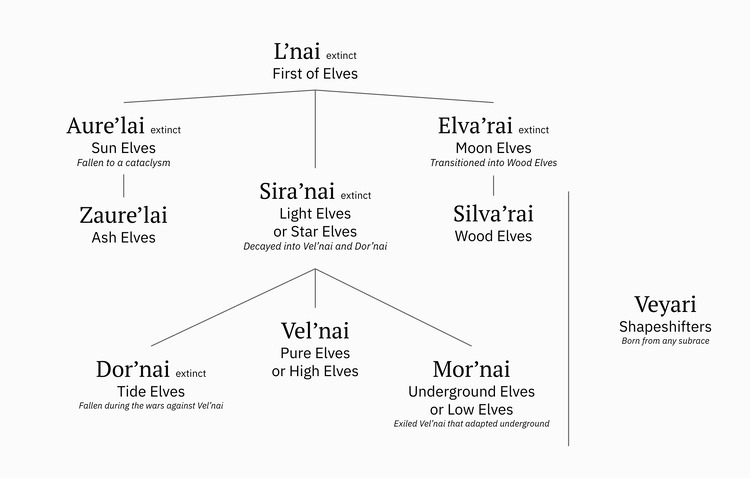
Culture
Sun Elven society was highly stratified, organized around arcane mastery, military discipline, and civic law. Institutions governed nearly every aspect of life, from magical education to conscription and state rites. Aurelian cities functioned as centers of bureaucracy and magical engineering, with ruling councils composed of archmages, generals, and priests.
Though aloof and formal to outsiders, the Sun Elves were fiercely loyal to the ideals of order and self-mastery. They believed that through arcane structure and civic design, chaos could be subdued and the world brought into alignment with their vision of perfection.
Religion and Beliefs
Sun Elves followed a system of metaphysical governance rather than conventional worship. They revered solar radiance not as a god, but as the highest manifestation of order, reason, and vitality. Religious institutions were integrated into the state, where rituals reinforced loyalty, memory, and civic duty.
Key conecpts included:
- Solar Dominion: The belief that the sun was a mirror of the ideal state—constant, impartial, and life-giving.
- Arcane Mandate: Magic was considered a civil responsibility and divine right, entrusted to the disciplined few.
- Cycle of Order: A calendar of military, seasonal, and magical alignments used to guide all aspects of society.
Temples were often built on sun-aligned axes, using refracted light in ritual and recordkeeping, and fire was used ceremonially.
Legacy
Although the civilization of Aurel has vanished, the legacy of the Sun Elves continues through their descendants. The Ash Elves of Verokuna carry fragments of their rites and architectural models, while the High Elves (Vel’nai) replicated their centralized governance and hierarchical traditions.
In many traditions, the return of Aurel is seen as a mythic prophecy for al elven races.
